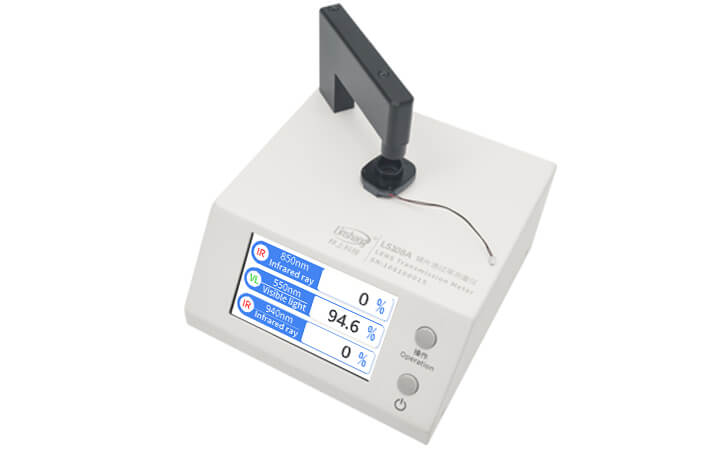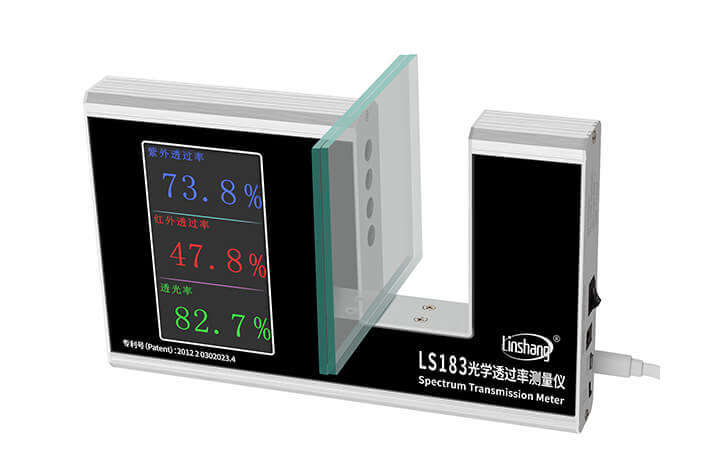Spectrum Transmission Meter Used For Optical Transmittance Test
Different industries have requirements for testing the transmittance of materials. Since the products that need to be tested for transmittance varies, so does the detection and selection of spectrum transmission meters.
I. What’s the use of spectrum transmission meter?
Nowadays, like glass, window film, PC, spectacle lens, mobile phone cover, acrylic, etc., there is a demand for testing transmittance. The spectrum transmission meter is mainly used to measure the transmittance of materials. The transmittance of materials is an optical property.
In addition to measuring the transmittance of materials, the spectrum transmission meter can also be used to judge the uniformity of materials. In order to ensure the thickness of the processed product, or whether the printing is uniform, many manufacturers will use the spectrum transmission meter to detect and judge so as to continuously improve the production process and improve product quality.
II. Transmittance testing and spectrum transmission meter selection
There are many models of Linshang spectrum transmission meters. Although they all look similar in appearance and the prices are relatively close, the application industry is still very different. There are often some customers who do not know how to choose. For the selection of the Linshang spectrum transmission meter, you can refer to the selection below.
1. Blue-violet light transmittance test of spectacle lens
Blu-ray is abundant in mobile phones, TVs, computer monitors, digital electronic product displays and car lights. High-energy short-wave blue light is one of the factors that cause human eye fatigue. Products such as anti-blue light protective film and anti-blue light glasses can play a certain role in protecting the eyes. The effect of detecting anti-blue light materials can be detected by LS108 spectrum transmission meter. The spectrum transmission meter is suitable for testing light-transmitting materials such as eyeglass lenses, anti-blue light materials, organic materials and coatings.
Parallel light design, stable and accurate test results
395nm, 430nm, white light 380nm-760nm transmittance test
Linshang LS108 spectrum transmission meter plays a very important role in the production, inspection and sales of anti-blue light products. The detection method is as follows:
Insert the USB cable, press the power button to turn on the meter.
After the real-time dynamic self-calibration, when the three data display is 100, start the test.
Put the test material in the corresponding test hole, the test result will be displayed immediately.
2. Mobile phone panel transmittance test
Today's smartphones have distance sensors and light sensors. The distance sensor can sense the distance between the phone and the human face during a call to automatically turn off the screen, which can prevent operations such as accidental touch of the face. The light sensor can realize functions such as automatic adjustment of the screen brightness.
The two small holes on the lens of the mobile phone have requirements for testing the infrared transmittance and visible light transmittance. At the same time, the camera and the main plane of the lens also have requirements for testing the transmittance. The LS108A and LS108D lens transmission meters are professionally used for the transmittance test of mobile phone panels. It can also be used to detect the infrared transmittance of remote control windows, infrared filter bars, sweeping robots and other products.
LS108D measuring aperture is 0.5mm
550nm, 850nm and 940nm wavelength transmittance test
LS108D has fast and slow measurement mode
Linshang LS108A and LS108D lens transmission meters will be provided with computer software at the time of purchase, which is very convenient for batch statistical test results and analysis on production lines. The method of use is as follows:
Plug the instrument into the USB cable first and then press the power button to boot.
After the real-time dynamic self-calibration, when the three data display is 100, start the test.
Align the light sensor and the distance sensor to the test hole and the corresponding test results will be displayed immediately.
3. Transmittance testing of other materials
For the detection of the transmission rate of other irregular or small-sized materials, Linshang Technology also has corresponding instruments. The LS108H spectrum transmission meter is very suitable for testing small-sized materials. It can be used to detect the transmittance of plastics, glass, coating materials, organic materials, paints and other materials.
The thickest material can be measured about 24mm
Test UV 365nm, IR 940nm, visible light 380nm-760nm
Linshang LS108H spectrum transmission meter is designed with parallel light. This spectrum transmission meter can also be used to test relatively thick materials. The method of use is as follows:
Insert the USB cable, press the power button to turn on the meter.
After the real-time dynamic self-calibration, when the three data display is 100, start the test.
Place the material to be tested in the test hole and immediately display the test result.
For the transmission test of general materials such as glass and film, the LS183 spectrum transmission meter also plays an important role. The instrument is suitable for the transmission testing of thermal insulation coatings, films, insulating glass, stick-film glass, PC, PMMA and other materials.
Parallel light design, accurate measurement of large thickness materials
Test UV 365nm, IR 940nm, visible light 380nm-760nm
The LS183 spectrum transmission meter uses a U-shaped groove design, which is relatively wide. It is also very convenient when testing materials of large thickness. The method used is as follows:
Connect the USB cable and turn on the button on the side of the instrument
After passing the self-test, when all three data show 100%, you can start the test
Put the test materials into the card slot and the three test results will be displayed immediately
Through the dial switch on the side, you can switch between three different display interfaces, available in Chinese, English and graphic display.
- Features of the LS183 UV Transmittance Meter
- Difference between Visible Light Transmission Meter LS183 and LS108H
- Spectacle lens anti-blue light detection---blue-violet light transmittance meter
- Spectrum Transmission Meter for Measuring PC Sheet
- Difference between LS103A and LS183 spectrum transmission meter
- Measuring the Transmittance of a Hemisphere by Plastic Transmittance Meter



